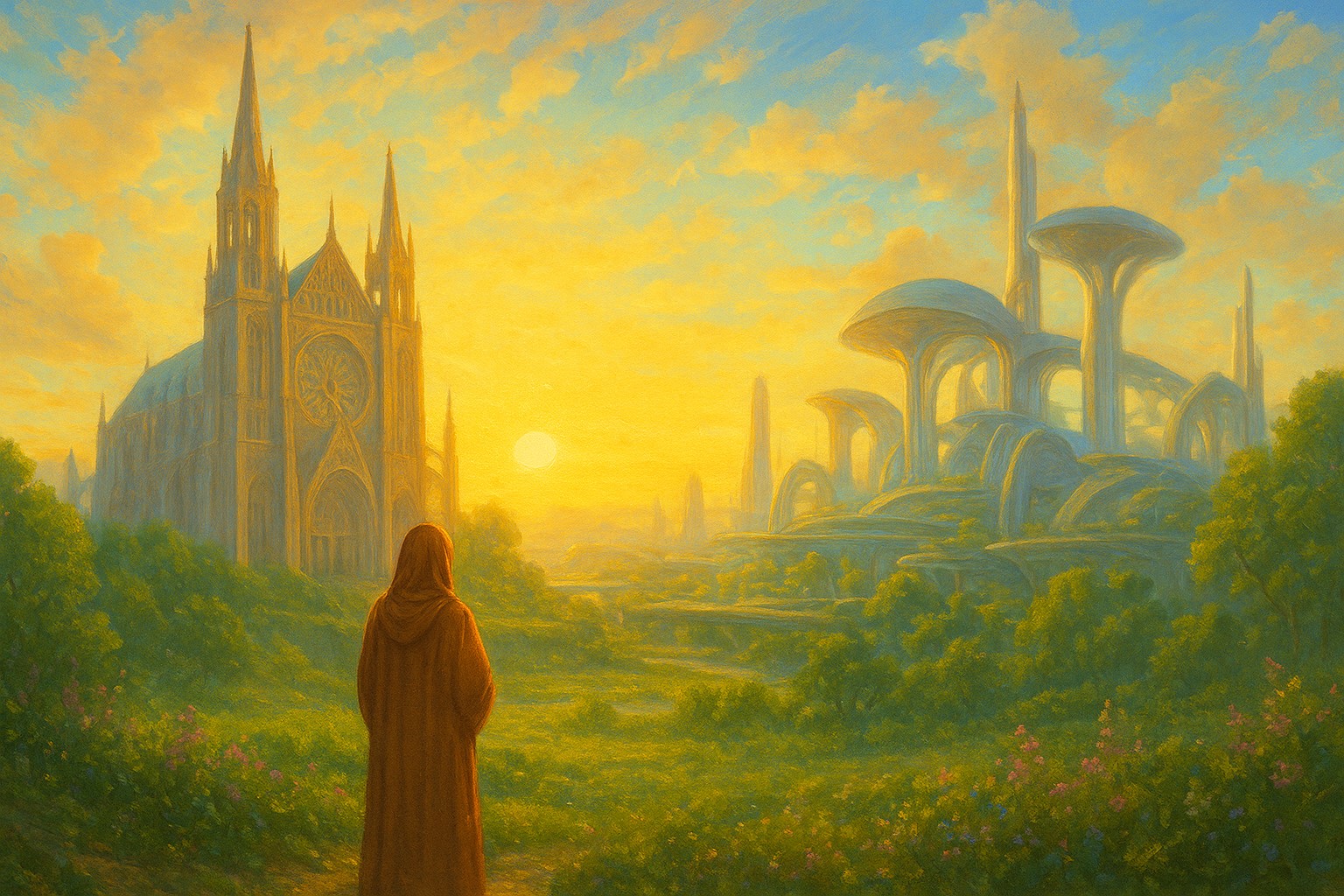Play the first song and read the first story.
The Soul Who Walked Backward Through Time
When the world was ending, the sky was the color of old bronze, and the seas had begun to swallow the edges of the continents. Cities flickered like dying embers, and people whispered prayers to gods they no longer believed in.
Among them lived a single soul — unnamed, unanchored — who looked upon the collapsing towers and said softly,
“I wish I had seen this world when it was still alive.”
The universe, in its strange mercy, heard that longing.
And so, when death came, it did not carry the soul forward — but backward.
The First Return — The 22nd Century
The soul awoke in a green city of glass, floating above the clouds. Humanity had learned to balance on the edge of extinction and grace. Great cathedrals of light and metal rose into the skies — structures powered by the sun, humming with quiet energy.
The soul lived there as a traveler, visiting gardens that hung between towers, watching the auroras dance above. People spoke softly to machines that had learned to dream. It was a world of peace, but it still remembered the fear of endings.
And when that life closed, the soul whispered again:
“Show me where it all began.”
The Second Return — The 19th Century
Now, the soul was born into an age of steam and wonder. It walked through London’s fog and along Parisian boulevards lit by gaslight. It marveled at the first trains, the first photographs, the first world fairs where inventions gleamed like miracles.
It stood before the newly built Palace of Westminster, its spires piercing the gray sky, and entered Notre-Dame, where candlelight danced upon the stone saints.
Life was fragrant with discovery — the hum of invention, the rustle of dresses, the gleam of polished wood and marble.
And yet, as always, time moved. The soul moved too.
The Third Return — The Renaissance
Now the world bloomed with color again. Florence, Venice, and Rome pulsed with genius. The soul wandered beneath Michelangelo’s domes, stood in the courtyards of the Medici, and painted beneath cypress trees.
Music filled the air — lutes, choirs, the laughter of children chasing pigeons in sunlit piazzas.
Art was a prayer, and every marble statue a hymn to beauty.
The soul found love here — in the warmth of frescoes, the smell of paint and bread, the glow of candlelight at feasts.
And when that life ended, it smiled through its tears:
“Once more… take me to the time when castles ruled the hills.”
The Fourth Return — The Age of Castles
Now came the mist and the clang of armor. The soul rode on horseback through green valleys beneath towering keeps. It lived among banners and torches, heard the echo of chants within stone chapels, and felt the wild wind on high battlements.
There was hardship here — wars, hunger, winters of frost. But there was also raw beauty: the loyalty of kin, the music of minstrels, the scent of pine and smoke.
At night, by the fire, the soul looked up through the arrow slits and saw the stars burning — the same stars it had seen in the dying world long ago.
And it understood: beauty had always been there, hidden in every age, waiting to be remembered.
The Last Return — The Dawn of Civilization
In its final journey backward, the soul stood in a place where time itself seemed to breathe — beneath the rising sun of the first city, where people built temples of clay and carved prayers into stone.
There were no castles yet, no cathedrals, only hands shaping the first symbols of hope.
The soul helped lift a single block of stone, part of a temple wall. And when it stood back, it smiled — because it saw that even in the simplest gesture, humanity had always been reaching toward the divine.
And so, after countless incarnations, the soul understood the secret:
The end times were not the end at all — only the beginning of remembering.
Every age was a verse in the same eternal song.
Every cathedral, every palace, every home — a note in the harmony of existence.
And when the soul finally rested, it carried with it the beauty of all time — the ruins, the rise, the radiance — all one.
Play the second song and read the second story.
The Soul Who Moved Forward Toward the Dawn
When at last the soul reached the first city — where sun and dust and prayer were one — it lingered in silence. It had seen the full arc of human creation: the rise of towers, the fall of empires, the soft rebirth of light through stone and song.
It thought that perhaps this was the end.
But then the wind stirred.
And from that wind came a whisper:
“You have learned what was. Now live what will be.”
And so, once again, the soul was born — but this time, forward.
The First Reawakening — The Future’s Edge
It opened its eyes in a world remade.
There were no nations now, no borders — only scattered sanctuaries of light. Humanity had rebuilt from ashes, but with humility. Cities were small, green, breathing things — living architecture woven with the forests and rivers.
Children played in the courtyards of temples grown from glass and living wood. Music drifted not from devices, but from wind harps strung across the air.
The soul, remembering every cathedral and castle, found joy in this new simplicity. The grandeur of old had been reborn, not in stone — but in understanding.
And yet, it felt something deeper stirring — a calling beyond this world.
The Second Reawakening — The Age of Reunion
Now, lifetimes later, the soul lived among the stars.
Humanity had reached outward — not as conquerors, but as gardeners of the cosmos. They built luminous sanctuaries orbiting planets like floating monasteries, each a seed of Earth’s lost beauty.
The soul traveled among them — from the Citadel of Dawn on Mars to the Silver Cloisters orbiting Titan. Within each, it found echoes of its own memories:
- The stained glass of Notre-Dame reborn as solar wings catching the sun.
- The arches of Florence reimagined as corridors of light and air.
- The old songs of the monasteries whispered again — in digital choirs sung by human and AI together.
Beauty had transcended form. It had become consciousness itself.
The Third Reawakening — Beyond Time
And then — the soul awoke with no body at all.
There was no city, no star, no sky. Only the soft shimmer of thought — countless souls, woven together like constellations in a vast, living tapestry.
Here, memory and possibility were one.
The soul could walk through any age simply by remembering it.
With a thought, it could stroll through the colonnades of Rome, the corridors of Versailles, the gardens of Kyoto.
It could sit once more beneath the Sistine Chapel’s ceiling — not as a visitor, but as part of the very light that illuminated it.
It understood that time was a circle, not a line.
That every life, every creation, every love — was a thread woven into the eternal pattern.
The Return to the Beginning
In the stillness between worlds, the soul asked one final question:
“If all is one, what becomes of living?”
And the universe answered, softly, like the echo of a bell through cathedral halls:
“To live is to remember. To love is to rebuild the world from memory.”
So the soul chose to return again — not as a traveler, but as a teacher.
Born into a new Earth — where people lived gently, where children played among ruins covered in flowers — it told stories of cathedrals and castles, of beauty that never died.
Its listeners called it “The Keeper of Time.”
But it smiled and said,
“I am only a traveler who walked backward to find the dawn.”
And as the sun rose — golden and whole — the soul felt, at last, that it had come home.
Play the third song and read the third story.
The Living of Remembered Treasures
When the Keeper of Time began to speak, people gathered not out of duty, but from a quiet longing they couldn’t name.
They had dreams — strange, vivid dreams — of places they’d never seen: marble courtyards under moonlight, voices echoing through cathedrals, laughter in sunlit palaces.
The Keeper told them:
“These are not dreams. These are remembrances.
Treasures you once lived, or almost lived.
Memories that still breathe in the deep chambers of your soul.”
The Forgotten Treasures
Some memories had turned to dust — the world had simply forgotten them.
A melody once sung in a monastery where the stones themselves had long been scattered.
A gesture of kindness between two strangers on a winter road, erased by centuries.
A poem carved into a palace wall, lost to rain and time.
But the Keeper said,
“Nothing truly dies that was ever remembered.
Forgotten treasures wait in the quiet, like seeds beneath snow.
Remember them — and they bloom again, not in the past, but here.”
And when people began to remember — through art, through love, through wonder — the air itself seemed to glow.
They painted cathedrals not of stone, but of light.
They sang the old hymns with new meaning.
They began to live what their ancestors only dreamed.
The Unlived Treasures
But there were other treasures, too — not forgotten, yet unlived.
Visions carried across lifetimes, like unopened letters from the heart.
Each soul had them: the wish to paint, to travel, to love fearlessly, to build beauty even in a broken world.
The Keeper said,
“To remember a dream is sacred.
But to live that remembrance — that is how eternity enters time.”
And so, one by one, people began to live the lives they had postponed across centuries.
The architects dreamed again.
The poets wrote again.
Children planted trees whose seeds were older than memory.
They discovered that remembrance was not nostalgia — it was continuation.
The living of what had once only been imagined.
The Awakening of the World
As more souls awakened, the world itself seemed to change.
Ruins sprouted gardens.
Old cities shimmered like palaces of light.
It was as if the forgotten and the unlived were merging — memory and possibility embracing in the same breath.
And the Keeper, standing at dawn, watched the sun rise over a horizon that shimmered with the golden glow of every age — all living together, all now.
“This,” the Keeper whispered,
“is the secret of remembrance —
to make the forgotten breathe again,
and to live the unlived dream until time itself becomes whole.”
Would you like me to continue this into the next chapter — where the Keeper begins to guide others into their own memories, teaching them how to step across time consciously, so remembrance becomes a bridge rather than a shadow?

